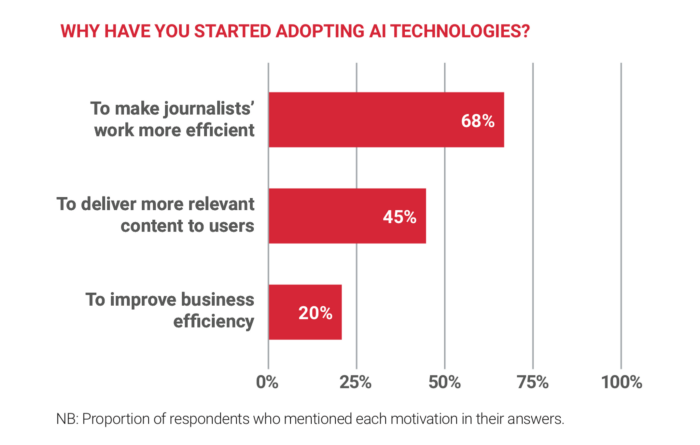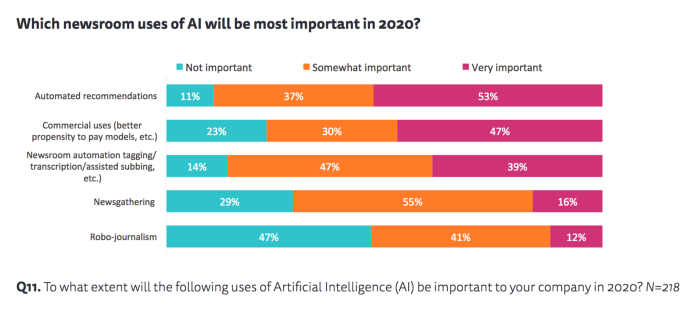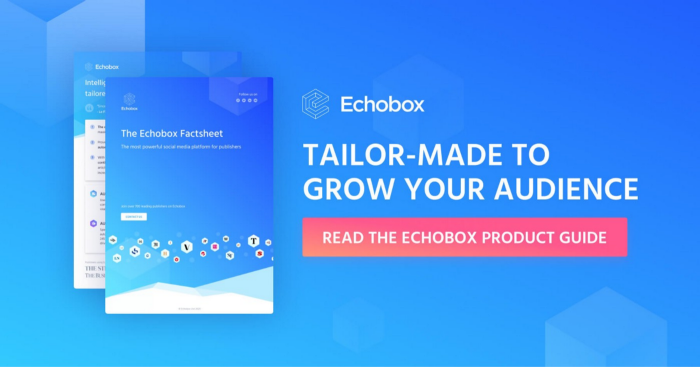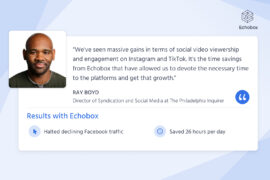If you’re working from home at the moment, like many people around the world, this might be the right time to finally catch up on some reading and reflection.
In this article, we highlight 3 of our favorite research reports we’ve read in recent months about journalism and artificial intelligence (AI), and share the most salient takeaways for publishers. We hope these insights will provide you with new perspectives and concrete examples of AI’s diverse applications for publishing organizations.
1. “New powers, new responsibilities: A global survey of journalism and artificial intelligence” from LSE Polis
Why read it?
This 111-page report depicts publisher attitudes towards and adoption of AI and associated technologies, with participation from 116 journalists at 71 news organizations in 32 countries.
Through survey questions and interviews with a wide range of journalists, LSE Polis provides a fascinating view of how publishers understand and interpret the notion of AI, how they’re using it in different ways, and the opportunities and risks AI presents. We recommend this report to any publisher who is curious about how their peers are approaching AI and their strategies for newsroom application.
Our favorite insights from this report:
- Two-thirds of publishers use AI for news production
- More than half of publishers use AI to distribute content
- 68% of journalists adopted AI to make their work more efficient
- 45% adopted AI to deliver more relevant content to audiences

Key takeaways from this report:
“It is important to have an organisational definition of AI to help shape strategy and to promote understanding and communication about AI in the newsroom.”
“Newsroom roles were seen to be changing more through the augmentation of current roles rather than the replacement of jobs. There would be new tasks for people in existing roles and new workflows, but few AI-specific new roles.”
“AI will re-shape journalism in an incremental way but with longer-term structural effects that reflect how news media is changing for other reasons: technological, social, and commercial. In a more networked world AI will become more important in all fields.”
Read this report from the JournalismAI project at LSE Polis.
2. “Journalism, Media and Technology Trends and Predictions 2020” published by the Reuters Institute for the Study of Journalism
Why read it?
A survey of 233 professionals from both traditional and digital media organizations, this report provides a unique window into what publishers expect to see and do this year.
From revenue streams and the rise of audio to tech platforms and government regulation, this report outlines key trends for the publishing industry’s most vital issues.
Especially thought-provoking are the five forward-looking essays, written by the study’s authors, which conclude the report. These essays provide a fresh take on major challenges for many publishers today including: declining reader trust in news media, attacks and abuse from politicians and activists, and inter-generational tensions within the newsroom.
Our favorite insights from this report:
- 50% of publishers say reader revenue will be the most important revenue stream going forward
- 35% say a combination of reader revenue and advertising will be the most important revenue stream
- 53% of publishers say AI will be “very important” this year in the newsroom for automated recommendations
- 39% say AI will be “very important” for boosting efficiency in the newsroom via automated tagging, transcription, translation, etc.

Key takeaways from this report:
“Publishers will be pushing aggressively ahead with registration and log-in strategies following data privacy regulation and tightening restrictions on cookies by anti-ad-tracking browsers like Safari and Firefox. First-party data will be at a premium going forward but this is likely to further benefit platforms like Google and Facebook, which have hundreds of millions of authenticated and logged-in users. By contrast individual news publishers may struggle to persuade consumers to keep logging in. Expect more publisher alliances, like NetID in Germany and Nonio in Portugal, to counter this trend.”
“Facebook’s news tab is part of a wider trend, with platforms looking to create trusted and curated environments for news rather than mixing it with user-generated content. YouTube have started to inject trusted brands into the feed when big stories break and Google’s carefully selected news index does a similar job for AI-driven products like Discover. We’re also seeing more humans involved in the process, with platforms hiring editors to manage the nuances.”
Read this report from the Reuters Institute for the Study of Journalism.
3. “News Automation: The rewards, risks and realities of ‘machine journalism’” from WAN-IFRA
Why read it?
We found this report to be especially interesting because of its narrow focus on a specific application of AI in the newsroom: the automated production of news texts based on structured data.
It explores the idea that, contrary to the futuristic notions many may still have upon hearing the term “AI”, news automation is not a radical departure from traditional news production, but rather a natural progression of technological evolution in the newsroom.
The report features examples of how news automation is being practiced at varying levels in five major newsrooms in Europe, the US and China. WAN-IFRA also highlights important considerations when introducing news automation to the newsroom, such as data quality, the choice of in-house development vs. plug-and-play tools, and maintaining transparency for both journalists and audiences.
Our favorite insights from this report:
- Study participants mistook 21% of computer-written articles as written by humans
- …and they mistook 10% of human-written articles as written by computers
Key takeaways from this report:
“Automated systems can provide sophisticated alerts for journalists and editors when something interesting has happened or is about to happen. Algorithms are much better equipped to find hidden relationships and outliers than people.”
“Will your distribution systems and platforms handle the vast amount of texts produced when automating? The ability to produce very large amounts of texts in a short time is one of automation’s great strengths.”
“What we see is that automatically generated articles compete well in credibility with human-written content. The by-line information does not seem to have any significant impact on the perceived credibility (van der Kaa & Krahmer, 2014), at least not in the European context. In some cases (Graefe et al., 2016; Wölker & Powell, 2018), the automated content even got somewhat higher credibility ratings than the articles written by humans, especially in sports news (Wölker & Powell, 2018) — but, in general, the credibility of automated news can be considered to be on par with human-written news.”
Read this report from WAN-IFRA.
Did you know that more than 700 leading publishers worldwide are using Echobox’s artificial intelligence to share more than 10 million posts on social media?
Download our Factsheet to learn how Echobox is helping publishers use AI to boost their social media performance:
Photo by Miguel Á. Padriñán from Pexels




